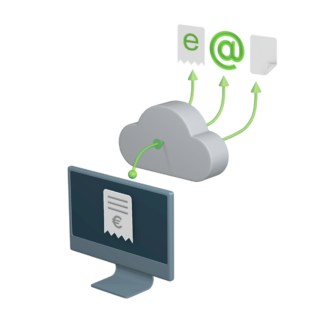
E-invoicing developments in Europe and the United States
Heikki Pulli
In this blog, I would like to take a closer look at e-invoicing developments in Europe and the United States as I just returned from a Business Payments Coalition (BPC) meeting. And also provide some more information about European developments.
A look at Europe
While there are a lot of developments in different areas of the EU, I won’t go into details of what our British friends are up to. Instead, I would like to highlight that the European Commission has published the e-invoicing Country factsheets that provide an overview of the state of e-invoicing in the different member countries. The data for these factsheets is provided to the Commission by members of the European Multi-Stakeholder Forum on Electronic Invoicing (EMSFEI). The EMFSEI oversees both the policy and also the technical implementation mandates for B2G (Business-to-Government) e-invoicing in the EU member states.
With country factsheets the European Commision is aiming to provide a visibility on how the European Directive 2014/55/EU on e-invoicing in public procurement, the adoption of the European standard on e-invoicing (EN 16931-1:2017) and the national Business to Government solutions are adopted throughout the different member countries.
This year, I believe the two things to highlight are two major updates. The first update is the country data related to e-invoicing implementation at the sub-central level. The second is the selected national e-invoicing monitoring strategy. The factsheets now feature information on those two parts. So in case you are interested in details I really recommend taking a bit of time and exploring these factsheets.
As highlighted before, we as a company are also continuing to further build out and enhance our support for the European norm within the CEF funding project.
E-invoicing across the pond
The developments in the US are in some way almost contrary to how the development in the EU is driven.
The EU and the different projects to drive e-invoicing forward are somewhat typical because in many markets the initiative for the infrastructure behind e-invoicing has come from the public sector. Peppol is a classic example that provides digital procurement paired up with message formats and infrastructure, all within an open and interoperable network.
In the US however, there is no public sector push. This is quite natural for a country that is heavily relying on the private sector. If we look at e-invoicing in the US, we see that it’s characterized by multiple technical standards, formats and networks. We have three-corner e-invoicing models and point-to-point connections, and this leads to closed networks, which are either established through direct connections between the involved trading partners (for example industry-specific networks), where a single e-invoicing service provider connects a buyer organization and its suppliers via a sort of tailor-made service.
This is where the Business Payments Coalition sets in. The mission of the BPC is to solve challenges related to processing information associated with B2B payments in order to promote the use of electronic payments and straight through processing (STP). In other words, the BPC aims to make the payment landscape in the US more efficient. It’s 2020, nobody should need to write checks for B2B payments. E-invoicing is in that sense a way to standardize and consolidate the vast landscape.
I am happy to be a member of the BPC E-Invoicing work Group. A bit more than a year ago I wrote about the steps the BPC takes in standardising the e-invoicing market in US. On November 1st last year the BPC published two of three new electronic invoicing reports as a part of its push for standardization and B2B payments efficiency.
The first report ‘Overview of an e-Invoice Interoperability Framework‘ Introduces the concept of an e-Invoice interoperability framework and a path forward for the BPC work assessing U.S. market needs. The second report ‘E-Delivery Network Feasibility Assessment Report‘ provides business and technology stakeholders with an understanding of the high-level requirements and standards required to establish an open, federated network of access points for the U.S. market. The quick summary we can make out of this is that the workgroup recommended using the CEF e-delivery model and UBL based invoice message.
In the most recent BPC meeting, the new scope for deliverance for 2020 was agreed. 2020 is the year where the theoretical findings of the reports will be put to a proof of concept (PoC). We agreed on the minimum content of the PoC and how to show to the audience that a proposed solution would be working. Although piloting of a production system is out of scope for this PoC, I think it is very important that we agreed to make a show-case for different market participants in order to create the necessary buy-in to move from theory to practice, after all market participants need to be on-board.
The agreed upon deliverables are:
- Demonstrate a functioning federated registry / SML architecture between three SMLs
- Demonstrate the ability for an access point to discover access points across multiple SMLs and SMPs
- Demonstrate standard functionality between access points from U.S., Canada, and Mexico (as defined by summary of recommendations in the Appendix)
- Document the steps to establish the network, including the decision processes
- Demonstrate to the industry the business and technical considerations associated with a federated registry/SML architecture network
- Contribute to the creation of a specification to standardize the way SMLs network
All this makes me really confident that the proof of concept will go beyond technical questions because technology can always be solved. The real challenge, especially in a vast landscape such as the US, is to get the different service providers and market participants on board.
I am excited to see these initiatives in practice and also to hear the different perspectives of the players in the market. But all in all, this leaves me hopeful for the future of e-invoicing in the US.
Get an e-invoice system

For the accounts receivable
E-invoicing in any channel and format, as preferred by your customers, complemented by PDF & paper invoicing.

For the accounts payable
E-invoice receiving from all channels and formats directly into your workflow system, complemented by PDF & paper receiving.